Diplomatic Bluebook 2021
Chapter 3
Japan's Economic Diplomacy to Promote National and Global Interests
2 Promotion of Economic Partnerships
In recent years, development of economic globalization movement has seen a growing prevalence in protectionism. In such circumstances, Japan has emphasized and steadily promoted Economic Partnership Agreements (EPAs) and Free Trade Agreements (FTAs), which help capture the vitality of the growing market overseas and strengthen the basis of the Japanese economy through measures such as the reduction or elimination of tariffs on goods as well as barriers on trade in services, and through rule-making for trade and investment. In 2020, the First Protocol to Amend the Agreement on Comprehensive Economic Partnership Among Japan and Member States of the ASEAN entered into force for Japan, Thailand, Singapore, Laos, Myanmar, and Viet Nam on August 1, as well as for Brunei Darussalam on October 1. Japan signed the Japan-UK CEPA on October 23 and the RCEP Agreement on November 15. As a result, the EPA/FTA ratio in Japan's trade (the ratio of trade value with countries that have FTAs already signed or entered into force with Japan, to the total trade value) reached 79.0%. This ratio becomes 86.1% when including the trade value with the countries with which Japan is currently in negotiations (source: Trade Statistics, Ministry of Finance, 2020).
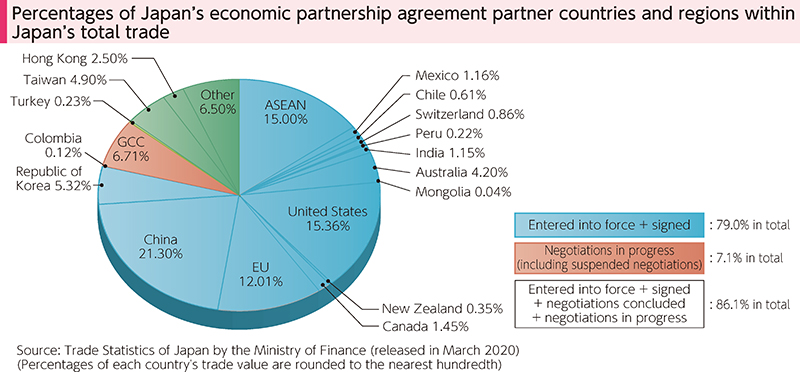
To advance a free and fair economic order, the basis for its peace and prosperity, Japan will continue to proactively continue its endeavors, including the early entry into force of the RCEP Agreement and full implementation of the Agreement, steady implementation and expansion of the TPP11 Agreement as the chair of the TPP Commission in 2021, and negotiations of other economic partnership agreements.
(1) Economic Partnership Agreements
A Comprehensive and Progressive Agreement for Trans-Pacific Partnership (TPP11 Agreement)
The TPP11 Agreement is an effort to establish new economic integration rules for the 21st century in a wide range of areas such as tariffs, services, investments, intellectual property and state-owned enterprises in the fast-growing Asia-Pacific region. It is also an opportunity for Japanese companies to better thrive in overseas markets, giving it important economic significance as a major driving force for the country's economic growth. Furthermore, the TPP11 Agreement has great strategic significance in that it facilitates the building of a free and fair economic order together with countries that share fundamental values such as freedom, democracy, fundamental human rights, and the rule of law, contributing to Japan's security and stability in the Asia-Pacific region as well as leading peace and prosperity in the region and the world at large.
The 12 countries of Japan, Australia, Brunei Darussalam, Canada, Chile, Malaysia, Mexico, New Zealand, Peru, Singapore, the U.S., and Viet Nam signed the Trans-Pacific Partnership Agreement (TPP12 Agreement) in February 2016. However, due to the U.S.'s announcement of its withdrawal from the TPP12 Agreement in 2017, Japan proactively led discussions among the 11 countries for the early realization of the TPP. At the TPP Ministerial Meeting held in Viet Nam in November 2017, the Ministers agreed (agreement in principle) to move forward with the new TPP11 Agreement among 11 countries by incorporating the articles of the original TPP12 drawn up by the 12 countries into the TPP11, while exceptionally suspending the application of certain articles. The TPP11 Agreement was later signed in Chile in March 2018. The six countries (Mexico, Japan, Singapore, New Zealand, Canada, and Australia), completed necessary domestic procedures and the Agreement entered into force on December 30, 2018. Furthermore, Viet Nam became the seventh Party to conclude the Agreement in January 2019.
In January 2019, after the entry into force of the TPP11 Agreement, Japan became the TPP chair and hosted the First Commission of the TPP at the ministerial-level. The Second Commission was held in October in Auckland, New Zealand. The Third Commission was virtually held in August 2020, with Mexico serving as the chair. At the meeting, Ministers confirmed the importance of promoting free trade through the TPP11 Agreement as part of the discussions centered on achieving economic recovery from the COVID-19 crisis. The Ministers also exchanged views particularly on the usage of the TPP11 Agreement for strengthening supply chains and digitalization. As the chair of the TPP Commission in 2021, Japan will work towards the steady implementation of the TPP11 Agreement in light of the economic conditions caused by COVID-19 and discussions at the Third Commission.
The TPP11 Agreement has significance in providing to the world a shared set of high-standard and balanced rules for the 21st century. A number of economies (countries and regions) have expressed interests in joining the TPP11 Agreement. The UK submitted a formal request to commence negotiations on acceding to the TPP11 Agreement in February 2021. While thoroughly assessing, with strategic perspectives, whether these economies are prepared to satisfy the high standards of the TPP11 Agreement in terms of market access and rules, Japan will continue to work toward the steady implementation and expansion of the TPP11 Agreement.
B Japan-EU Economic Partnership Agreement (Japan-EU EPA)
The Japan-EU EPA, which accounts for roughly 30% of global GDP and 40% of global trade, entered into force in February 2019. It is a model for a 21st century economic order based on free and fair rules. Although the UK withdrew from the EU at the end of January 2020, the combined economies of Japan and the EU amount to 20.7 trillion US dollars in GDP and 12.7 trillion US dollars in trade. It is the largest economic sphere after the RCEP, which was signed in November. Global trade volume declined due to the effects of the COVID-19 pandemic beginning in 2020. However, certain effects have been seen in the year since the Japan-EU EPA entered into force, including an increase in trade volume of such products as passenger cars and wine. Furthermore, the Japan-EU EPA has brought visible benefits to consumers such as the fairs related to the Japan-EU EPA organized by numerous retail stores and restaurants.
Since the agreement entered into force, Japan and the EU have steadily implemented this agreement by confirming the operational status and holding discussions on topics such as future initiatives for further promoting trade between Japan and the EU, through joint committees1 in accordance with the agreement, as well as separate specialized committees2 and working groups3 in 12 areas.
Japan and the EU share fundamental values that include freedom, democracy, market economy, human rights and the rule of law, and Japan has built a cooperative relationship with the EU in many areas as a key partner in tackling a range of global problems. Positioning the Japan-EU EPA as a legal foundation for furthering cooperation between Japan and the EU, these two parties are working to strengthen their coordination and address a range of problems by taking a multilayered approach that includes the existing policy dialogue between the relevant authorities in both parties and joint public-private initiatives.
- 1 Joint Committee: Held once a year, in principle, and co-chaired by ministerial-level officials (or their representatives) from both parties to ensure the proper and effective implementation of the Japan-EU EPA.
- 2 Specialized committees: Established under the EPA Joint Committee, with sessions held once a year, in principle, in the following fields: (1) trade in goods, (2) rules of origin and customs, (3) sanitary and phytosanitary measures, (4) technical barrier to trade, (5) trade in services, investment liberalization and electronic commerce, (6) government procurement, (7) intellectual property, (8) trade and sustainable development, (9) cooperation on regulation, and (10) cooperation on agriculture.
- 3 Working groups: Established under the EPA Joint Committees, with meetings held once a year, in principle, in the following fields: (1) wine and (2) automobiles and parts.
C UK-Japan Comprehensive Economic Partnership Agreement (CEPA)
The Japan-UK CEPA entered into force on January 1, 2021. Due to the UK's withdrawal from the EU, the Japan-EU EPA would no longer apply to the UK once the transition period ends on December 31, 2020, a date set in the withdrawal agreement between the UK and the EU. In light of this, negotiations began on June 9, 2020 toward building a new trade and investment framework between Japan and the UK that would replace the Japan-EU EPA.
Following an agreement in principle reached on September 11, 2020 and signings by Foreign Minister Motegi and Trade Secretary Elizabeth Truss on October 23, the new agreement was approved at the 203rd extraordinary Diet session and entered into force on January 1, 2021. While being based on the Japan-EU EPA, the new agreement establishes more progressive, higher-level rules in areas such as electronic commerce and financial services. The agreement is a particularly high-level document that guides discussions over international rule-making in the digital sphere. It establishes rules concerning the latest digital domains that are on the level of or above those in the TPP11 Agreement and the Japan-U.S. Digital Trade Agreement, including the prohibition of restrictions on the cross-border transfer of information, of requests for location of computing facilities, and of requests to disclose algorithms.
This agreement can be counted on to ensure the continuity of Japanese companies' businesses and promote further trade and investment between Japan and the UK in accordance with high standards. Roughly 1,000 Japanese companies are doing business in the UK and have created 180,000 jobs, making the UK their gateway to Europe. The agreement will serve as an important foundation for further strengthening good relations between Japan and the UK.
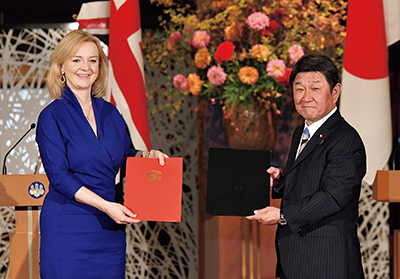 Japan-UK CEPA signing (October 23, Tokyo)
Japan-UK CEPA signing (October 23, Tokyo)Japan and the UK launched the negotiations of the Economic Partnership Agreement following the withdrawal of the United Kingdom from the European Union (“Brexit”) at the end of January. This EPA was signed unusually quickly, just four-and-a-half months after negotiations started in June, and it entered into force on January 1, 2021. As the impact of the novel coronavirus disease (COVID-19) spread across the world, and led to the stagnation of trade and investments, the conclusion of this agreement, which was negotiated primarily through videoconferences, sent a strong message on promotion of free trade to the international community. This Special Feature provides an overview of the Japan-UK EPA and its negotiation process.
Overview: Establishment of advanced rules based on the Japan-EU EPA
The Japan-UK EPA stipulates a new framework for trade and investment with the United Kingdom as a replacement for the Japan-EU EPA after Brexit. It is based on the Japan-EU EPA and comprises a total of 24 chapters. The contents can be broadly categorized into the section that prescribes how tariffs are reduced for trade in goods, and the section that sets out the broad rules concerning trade and investment. With regard to trade in goods, the tariff rate for exports from Japan to the UK is basically maintained at a similarly low rate with the Japan-EU EPA, with the addition of the immediate abolition of tariffs for certain items, such as railway rolling stocks and some automobile parts. As for agricultural, forestry and fishery products, the Agreement stays within the extent of the Japan-EU EPA, with tariffs on the UK kept at the same level as the Japan-EU EPA and no new tariff rate quotas introduced for the UK. The Agreement also stipulates new and more advanced rules than the Japan-EU EPA in some areas, such as electronic commerce and financial services, and is the first Japanese EPA that includes an independent chapter on gender while also prescribing bilateral cooperation to ensure that women benefit fully from trade.
Negotiation process: A trade agreement concluded unusually quickly against the backdrop of the COVID-19 pandemic
Against the backdrop of time restrictions due to the need of establishing a new Japan-UK trade and investment framework by the end of the Brexit transitional period (December 31, 2020) to avoid causing severe impact to Japan-UK trade, as well as the situation of the spread of COVID-19, the negotiations for this EPA, usually held through in-person meetings, were carried out by fully taking advantage of videoconferencing technology. Negotiators from the two governments surmounted the nine-hour time difference (eight hours during British summer time) to engage in videoconferences on an almost daily basis. At the ministerial level, videoconferences were held between Foreign Minister Motegi and Secretary of State for International Trade Elizabeth Truss, on June 9 when the negotiations were launched and on other occasions. However, as in-person consultations were also essential at important phases of the negotiation process, Foreign Minister Motegi visited the UK on August 5, marking his first overseas visit since the outbreak of the COVID-19 pandemic. For two whole days, he engaged in direct negotiations with Secretary of State for International Trade Truss, and they eventually reached an agreement in substance. After the two ministers confirmed the agreement in principle through the second videoconference on September 11, Secretary of State for International Trade Truss visited Japan on October 23 and a signing ceremony was held. The series of events, including the signing ceremony, took place with various COVID-19 measures in place. At the joint press conference held after the signing ceremony, the two ministers smiled and bumped elbows instead of exchanging handshakes, and the atmosphere was very convivial. The Japan-UK EPA, which entered into force on January 1, 2021, is expected to serve as an important foundation for further strengthening Japan-UK relations.
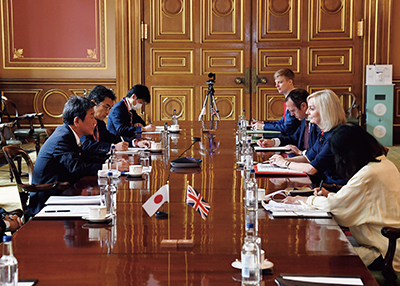 Consultation between Foreign Minister Motegi and Secretary of State for International Trade Truss (August, United Kingdom)
Consultation between Foreign Minister Motegi and Secretary of State for International Trade Truss (August, United Kingdom)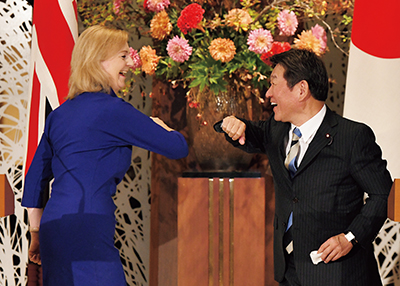 The two ministers after the signing of the Japan-UK Comprehensive Economic Partnership Agreement (October, Tokyo)
The two ministers after the signing of the Japan-UK Comprehensive Economic Partnership Agreement (October, Tokyo)D Regional Comprehensive Economic Partnership (RCEP) Agreement
The RCEP Agreement is an economic partnership agreement with a total of 15 member states, namely the ASEAN member states, Japan, Australia, China, the Republic of Korea (ROK), and New Zealand. RCEP participating countries account for roughly 30% of the world's total GDP, total trade, and population. Furthermore, trade value between Japan and RCEP member states account for just under 50% of Japan's total trade value. The RCEP Agreement aims to improve market access and promote regional trade and investment while boosting supply chain efficiency, by establishing rules in areas such as intellectual property and e-commerce that go beyond the WTO rules. The Agreement is expected to further strengthen Japan's ties with the regions serving as the world's growth center, thus contributing to the economic growth of Japan. It is also expected that the RCEP Agreement will serve to send a message that it will promote free trade amid worldwide concerns over protectionism that have grown particularly strong with the outbreak of COVID-19.
The negotiations of the RCEP Agreement continued for nearly eight years. Following a ceremony to launch RCEP negotiations during the ASEAN-related summit meeting held in Phnom Penh, Cambodia in November 2012, four summit meetings, 19 ministerial meetings, and 31 rounds of negotiations were held. The Agreement was signed on the occasion of the fourth RCEP Summit on November 15, 2020.
Although India had participated from the start of negotiations, at the third Summit in November 2019, India declared that it would not participate in further negotiations and did not sign the RCEP Agreement. However, at the signing, Signatory States issued a “Ministers' Declaration on India's Participation in the RCEP,” which clarified that the Agreement would be open for India, and stipulated a facilitation of India's future accession and allowed it to participate in related meetings as an observer. Japan proposed and led the discussion in issuing this declaration. Considering the significant economic and strategic importance of India's participation in the RCEP Agreement due to its population of more than one billion and its steady economic growth in recent years, Japan will continue to play a leading role for the future participation of India to the RCEP Agreement.
The RCEP Agreement is stipulated to enter into force for these signatory States that have deposited their instrument of ratification, etc., 60 days after the deposit by at least six signatory States that are Member States of ASEAN and at least three signatory States that are not the member states of ASEAN. Along with working to ensure the early entry into force of the RCEP Agreement, after its entry into force, Japan will coordinate closely with countries involved to enforce economic activity that is based on free and fair rules in the region by ensuring the implementation of the Agreement.
E EPAs Currently in Negotiation
(A) Japan-China-ROK FTA
The Japan-China-ROK FTA is a negotiation with Japan's major trading partners: China and the ROK. The negotiations were launched in March 2013 and 16 rounds of negotiations had been held as of December 2020. In accordance with the content of the RCEP Agreement, to which Japan, China, and the ROK participate, the three countries have been engaged in discussions concerning a wide range of areas including trade in goods, investment, trade in services, competition, intellectual property and electronic commerce with the shared objective of pursuing a comprehensive, high quality, and mutually beneficial FTA.
(B) Japan-Turkey EPA
As an important country that serves as a hub among Europe, the Middle East, the Central Asia and Caucasus region, and Africa, Turkey has considerable economic potential and is attracting attention as a production base for exports to surrounding regions. The country has signed FTAs with over 20 countries and regions, and the need has been recognized for Japan to develop conditions of competition for Japanese companies through the conclusion of an EPA. Furthermore, business communities in both countries have high expectations for an early conclusion of an EPA between the two countries. At the Japan-Turkey Summit Meeting in January 2014, the leaders agreed to launch negotiations, and 17 rounds of negotiations had been held as of the end of 2020.
(C) Japan-Colombia EPA
Japan began EPA negotiations in December 2012 with Colombia, a country with rich natural resources and high economic growth. Since Colombia has concluded FTAs with a number of countries (including the U.S., Canada, the EU and the ROK), it has been increasingly necessary for Japan to establish a competitive environment in the country. The strengthening of bilateral relations through an EPA is also expected to lead to improved cooperation in the international arena and promote cooperation among Japan and the Pacific Alliance (Mexico, Colombia, Peru, and Chile). Negotiations are currently ongoing.
F Existing EPAs
The existing EPAs contain provisions concerning the joint committee, which is a body that discusses the implementation of the agreements, and a process to review the agreements after a certain period of time following their entry into force. In addition, a variety of consultations are being held in order to smoothly implement EPAs after their entry into force.
In accordance with the EPAs, Japan has been accepting candidates for nurses and certified care workers from Indonesia, the Philippines, and Viet Nam. In total, 3,080 (as of FY2020) candidates have been accepted from Indonesia (since 2008), 2,592 (as of FY2019) from the Philippines (since 2009), and 1,340 (as of FY2020) from Viet Nam (since 2014). Acceptance of candidates from the Philippines for FY2020 is currently being coordinated. The total numbers of nurses and certified care workers who have passed national exams are 459 and 1,322 individuals, respectively, as of FY2019.
(2) Free Trade Area of the Asia-Pacific (FTAAP) Concept
The Lima Declaration on the FTAAP adopted at the 2016 Asia-Pacific Economic Cooperation (APEC) summit meeting confirmed mainly the following two points: (1) that the FTAAP would be high quality and comprehensive, and address next-generation trade and investment issues, being built in accordance with the TPP Agreement and the RCEP Agreement; (2) efforts would begin on implementing work plans supporting capacity building aimed at promoting the realization of FTAAP. In a progress report presented to leaders in 2020, the need was expressed for further efforts.
Since 2017, Japan has been continuously providing capacity building support through workshops and policy dialogues concerning the “competition chapters” in FTAs and EPAs. From the viewpoint of achieving a comprehensive and high-quality FTAAP, it is highly significant that the TPP11 Agreement entered into force at the end of December 2018 and that the RCEP Agreement was signed in November 2020.
(3) Investment Treaties, Tax Conventions, and Agreements on Social Security
A Investment Treaties
Investment treaties constitute an important legal basis to promote investments, by stipulating the protection of investors and their investment property, enhancement of transparency in regulations, expansion of investment opportunities, procedures for investment dispute settlement, and other matters. Japan has actively engaged in concluding investment treaties in order to promote the improvement of the investment environment overseas and to attract foreign investment to the Japanese market.
In August, the Japan-Jordan Investment Agreement and Japan-UAE Investment Agreement entered into force. As of the end of December 2020, there are currently 47 investment-related treaties that have entered into force (32 investment treaties and 15 EPAs), and six (three investment treaties and three EPAs) that have been signed but not yet entered into force, bringing the total to 53, covering 78 economies. As of the end of December 2020, including investment-related treaties that are currently in negotiation, treaties cover 94 economies and around 93% of Japan's direct investments overseas4 will be covered.
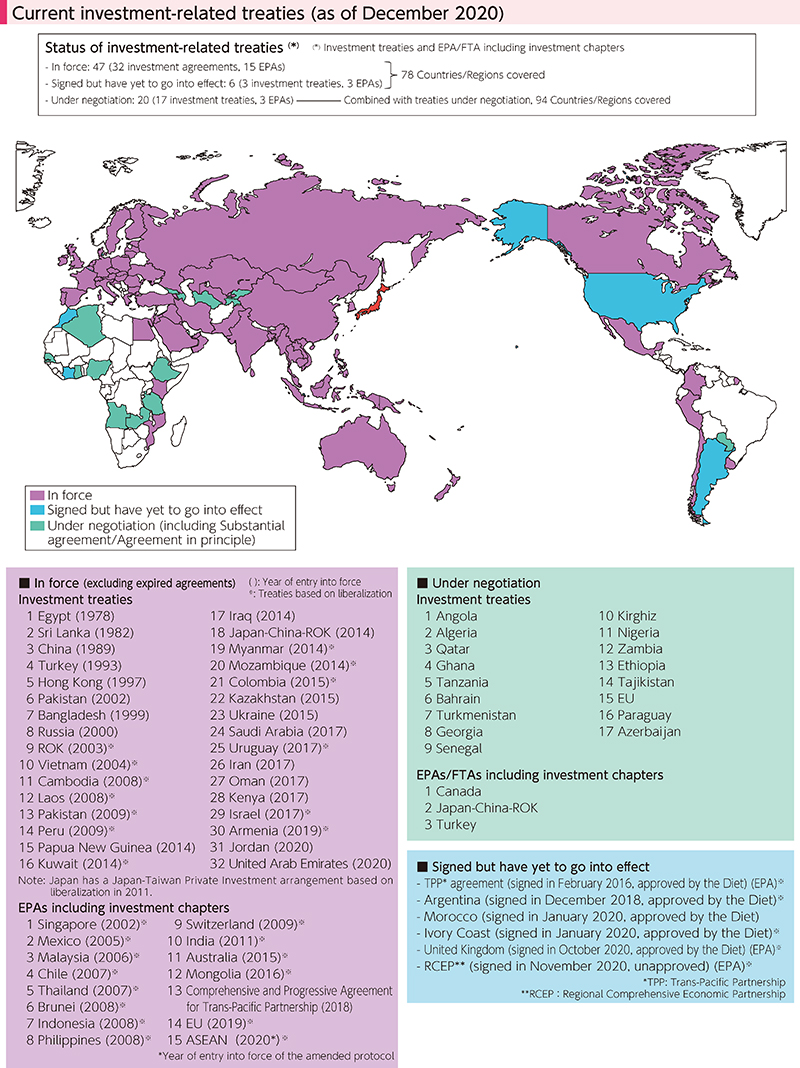
- 4 “Regional balance of Direct Investment (Assets),” Ministry of Finance (All regions) (As of the end of 2019)
B Tax Conventions
Tax conventions are intended to eliminate international double taxation in cross-border economic activities (e.g. to reduce or exempt withholding taxes imposed on investment income such as dividends), or to prevent tax evasion or avoidance, and provide an important legal basis for promoting sound investment and economic exchange between two countries. To support the sound overseas business expansion of Japanese companies, the Government of Japan is working to expand the necessary tax treaty networks, both in terms of quality and quantity.
Entering into force in 2020 were a tax treaty with Jamaica in September and a new (completely revised) tax treaty with Uzbekistan in October. Meanwhile, Japan signed tax treaties with Morocco in January and Serbia in July. Furthermore, in October a substantial agreement was achieved for a new (completely revised) tax treaty with Georgia. As of the end of December 2020, Japan has signed 78 tax treaties applied to 141 economies.
C Agreements on Social Security
Agreements on social security aim to resolve the issues of the double payment of social security insurance premiums and annuity insurance non-refunds. They are expected to facilitate interpersonal exchange and strengthen further bilateral relations, including economic exchange, by reducing the burden on Japanese companies and citizens working overseas. The total number of countries that have concluded or signed such agreements with Japan now stands at 23 as of the end of December 2020. In 2020, Turkey and Japan held intergovernmental negotiations toward the signing of a new agreement.

